On October 11 and 12, Fresh Plaza published the article titled ‘Different interpretations of new cold protocol holds up South African oranges in Portuguese port’; first in its English edition and then in its Spanish edition. The article refers to the retention of containers with South African oranges in the Portuguese port of Sines, stating that "some of which have been waiting for over two weeks to be cleared, and their number has since grown with the arrival of a second vessel last week."
In the article, Deon Joubert, the delegate of the Citrus Growers' Association (CGA) of South Africa in the EU, stated that "the situation has arisen from a difference in interpretation of the new cold protocol." Moreover, Joubert states that pulp temperature is not a precondition for EU market access, but instead the set point temperature of a container.
And the South African lobbyist continues: “The Delivery Air Temperature and setpoint of each container need to be used to measure the temperature of every container. It’s important to take note that the PPECB approves and signs off on every consignment’s temperature set point before shipment, to ensure compliance. The phytosanitary certificate, approved and signed off by DALRRD (Department of Agriculture, Rural Development and Agrarian Reform), serves as official proof that the consignment complies with EU regulations.”
According to Joubert, the situation has been caused by a difference in the interpretation of the new cold protocol. He said that "the day of stuffing/loading of the container should be used as an indication of when the cold treatment starts," but that “the Portuguese national plant protection organization interpreted it differently: the date on which the shipment was loaded onto the vessel was taken by them as the start of the cold regime, even if the stuffing date when the fruit was loaded into the container might have been a week earlier.”
“The day of stuffing/loading of the container should be used as an indication of when the cold treatment starts, but unfortunately it is not indicated on the phytosanitary certificate. Only the PPECB [Perishable Product Export Control Board] addendum contains this information. The Department of Agriculture Rural Development and Land Reform [DALRRD] is looking into adding this to the phytosanitary certificate,” stated Werner van Rooyen, COO at the Fresh Produce Exporters Forum, in the same article.
First conclusion
This proves non-compliance with the cold protocol on the grounds of "differences of interpretation", as they admit themselves. In reality, there is no ambiguity in the cold treatment regulation. The mandatory cold treatment for oranges imported into the EU from countries affected by the ‘False Codling Moth‘ (Thaumatotibia leucotreta or FCM) as a phytosanitary measure to kill this insect's eggs and larvae and prevent the entry, establishment, and spread of this quarantine priority pest, is simply not being complied with. (Countries in the African continent affected by the 'False Codling Moth' pest: Cape Verde, Israel, Madagascar, Mauritius, Reunion, and St. Helena)
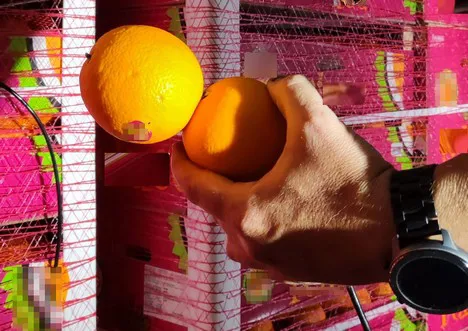
According to the NIMF-42 standard signed by South Africa, as part of the International Plant Protection Convention (IPPC), the temperature of the treatment must be verified from the central part of the 'product', as can be seen here.
The EU Regulation explicitly states that the treatment should be applied in accordance with the requirements set out in the International Standard for Phytosanitary Measures ISPM 42 (Requirements for the use of temperature treatments as phytosanitary measures). According to this standard, "the requirement of a temperature treatment is that the scheduled temperature is attained throughout the commodity (not the air) for the specified treatment duration, allowing the required efficacy to be achieved." The standard also states that "the specified level for each parameter should be met to achieve the required efficacy."
In addition, ISPM 42 states that “cold treatment uses refrigerated air to lower the temperature of the commodity to or below a specific temperature for a specific period. Cold treatment is used primarily for perishable commodities that are hosts of pests that are internal feeders" and -it adds- "prior to beginning treatment, the commodity may be precooled to the temperature at which the commodity will be treated."
It's important to note that, according to the standard: “Cold treatment requires monitoring of the core temperature of the commodity and adequate air circulation to ensure that the required temperature is uniformly maintained."
Therefore, in accordance with the wording of International Standard ISPM 42 applicable for the transitional protocol for 2022 and the definitive protocol starting 2023 within the framework of the Community Regulation, which was signed by South Africa as a contracting party to the International Plant Protection Convention (IPPC), exporters must verify that the commodity's core temperature, i.e. the temperature of the fruit's pulp, has reached the treatment temperature before the treatment duration's time begins to be recorded. The temperature of the fruit's core should be monitored and recorded and it should not exceed the specified level for the duration of the treatment.
The IPPC's ISPM standards are the only international standards for phytosanitary measures that the WTO SPS Agreement recognizes as the basis for phytosanitary measures applied in trade by WTO Members.
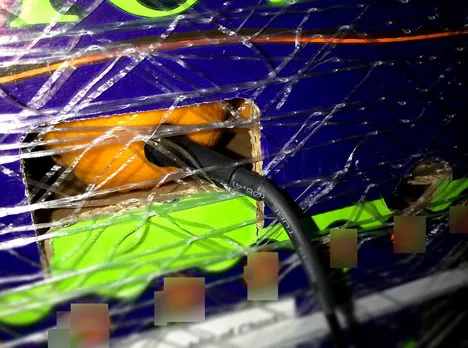
Example of a core sensor used to measure the cold treatment temperature as required by EU protocol but, in this case, in a shipment of Spanish oranges to a third country.
Second conclusion
A majority of EU importing countries isn't complying with the import control and verification of cold treatment compliance. The South Africans claim that pulp temperature is not a precondition for EU market access, but instead the set point temperature of a container, and that “the Delivery Air Temperature and setpoint of each container need to be used to measure the temperature of every container.”
Thus, if the vast majority of containers that have been imported were transported considering that the ambient temperature of the container applied by the South Africans and approved and certified by the Department of Agriculture, Rural Development, and Agrarian Reform (DALRRD) is the appropriate treatment temperature, one can only conclude that the correct compliance of cold treatment is not being controlled, except in honorable exceptions. Most of these exceptions, which are called an "annoyance" in the article, such as that of the Portuguese port of Sines, take place in countries with interests in Community citrus production and for which the import of citrus from countries affected by the 'False Codling Moth' poses a high phytosanitary risk for their citrus production.
According to ISPM 42 to which the EU Regulation refers, “monitoring of the air temperature provides useful information for the verification of the commodity treatment, but not as a replacement for commodity temperature." Therefore, in 2022 the pre-refrigeration is +5ºC in the fruit's core because temperatures in cold treatments always refer to the core temperatures of the commodity. Likewise, the cold treatment for at least 25 days at a set temperature between -1°C and +2°C refers to the core temperature of the commodity. The same can be said of the mandatory treatment starting 2023; the temperature of the treatment refers to the core temperature of the commodity, i.e. of the central part of the orange.
There has never been a cold treatment in which the temperature refers to the temperature of the air in the container (set point temperature), ever. Under no circumstances does a cold treatment refer to the installation of a Ryan® temperature recorder in the container by the exporter in the country of origin. In addition, upon unloading, the data recorded by the Ryan® -provided that it is below the treatment temperature- does not validate compliance with the mandatory cold treatment and allow the entry of the imported orange into the EU from countries with ‘False Codling Moth’.
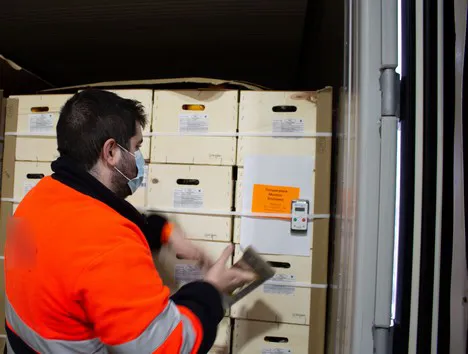
Ryan® type temperature recorder in the container (the device on top of the orange adhesive attached to the pallet), which is not used to guarantee cold treatment but to measure the ambient temperature of the container.
Cold treatment requires monitoring
Cold treatment requires the monitoring of the temperature of the core of the commodity and adequate air circulation to ensure that it is maintained in a uniform and stable manner. The temperature of a cold treatment can never refer to the container's set point because, as is well known, the container itself won't be able to keep it stable because of energy-saving systems for reefer containers - which seek to reduce energy consumption by maintaining the quality of the product by increasing temperatures and strong blowings-, or because of defrosting every 6, 9, or 12 hours, or according to the need of each evaporator, which stops blowing at set point temperature and the blowing temperature is set at +4 ºC.
The need for cold treatment can be discussed and explained, but how to apply it is not up to interpretation. ISPM 42, the regulatory framework established in the EU regulation that introduces cold treatment, leaves no doubt: cold treatment requires monitoring of the core temperature of the commodity (pulp temperature) through at least three core sensors. It also requires that the scheduled temperature is attained throughout the commodity for the specified treatment duration, allowing the required efficacy to be achieved.
Cold treatment is not being complied with and its compliance isn't being controlled appropriately because exporters are not using any core sensors in their shipments. This means that they don't have, as required by the regulations in the event that the cold treatment is applied during transport, maintenance, and delivery, upon request, of the temperature records of at least three core sensors. A phytosanitary certificate, approved and signed by the DALRRD based on container ambient temperature cannot serve as official proof that the consignment complies with EU regulations. It would seem, however, that the importing countries are turning a blind eye to this non-compliance by not requesting the records.
Third conclusion
There is a double non-compliance taking place, as they have admitted, once again, due to different interpretations. According to them, "the day of stuffing/loading of the container should be used as an indication of when the cold treatment starts" and they wonder if "the Portuguese national plant protection organization interpreted it differently: the date on which the shipment was loaded onto the vessel was taken by them as the start of the cold regime, even if the stuffing date when the fruit was loaded into the container might have been a week earlier."
However, cold treatment can only begin on the day the commodity is loaded into the container if the commodity, in this case, the oranges, has been pre-cooled to treatment temperature.
Up until December 31, 2022, the pre-cooling of the imported orange should have been stipulated, in accordance with ISPM 42, at the temperature at which it must be treated, which in this case is +2 °C, as established by all cold protocols. However, at the request of South Africa in the course of negotiations with the EU in May, oranges will have to undergo a pre-cooling phase of their core of only +5°C instead of +2°C, which makes no sense and means a relaxation of the cold treatment in addition to a higher phytosanitary risk. Therefore, the treatment cannot start from the closure and sealing of the container by the National Plant Protection Organization of the exporting country to the EU because the fruit's core has not reached the temperature of the cold treatment.
This is why the Portuguese national plant protection organization's actions were right and they did not consider that the date on which the fruit was loaded into the container was the starting date of the protocol.
Starting in 2023, exporters will be able to choose between two options, both of which require precooling the oranges to the treatment temperature. The first option: precooling at 0ºC and 16 days between -1ºC and 0ºC; and the second option: precooling at 2ºC and 20 days between -1ºC and 2ºC. The temperatures always refer to core temperatures.
These 'interpretations' are being used as a pretext to build and implement a 'false cold treatment' and the pseudo control of the orange import campaign from countries with 'False Codling Moth'. Then, when they are faced with a rigorous application of the rule, they argue that "given the disparity in the interpretation of the EU regulation by the different EU member states, South African exporters must shoulder the resulting financial costs" and describe the situation as an "annoyance."
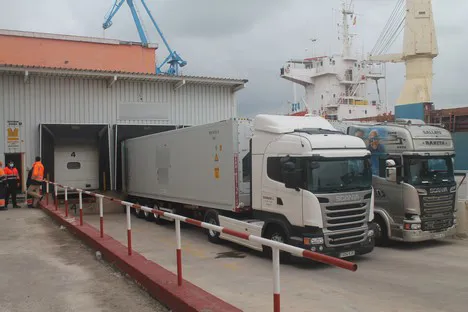
A shipping company's trucks with containers that have been approved for applying cold treatment.
Non-negotiable issues
It seems that the issues that are non-negotiable in our exports to citrus-producing third countries due to mitigation of phytosanitary risk are "interpretable" and considered ok when it comes to imports.
Meanwhile, on October 18, South African operators, again in Fresh Plaza, stated that they had sent the last shipments of citrus fruits to the United States and celebrated the record volumes of Navels exported and the high demand for mandarins. We have verified that South Africa complies with cold treatment (T107-e Citrus), pre-clearance (inspection at origin), and the monitoring of the temperature of the fruit's core by means of three sensors inserted in the pulp to export its oranges and mandarins to the USA. So it's funny, to say the least, that South Africa doesn't complain about a cold protocol that is much more demanding than the one required by the EU. In fact, South Africa is exporting 40,000-50,000 metric tons of oranges, more than 40,000 metric tons of mandarins, and 9,000 metric tons of grapefruit to the US with a more intense cold treatment (22 days at -0.55°C) than the one required by the EU. This means they can afford and are capable of implementing it. However, there is a difference: the United States is a single 50-state country and the EU is a political community of law constituted under the sui generis regime of an international organization founded to promote and welcome the integration and common governance of 27 European countries.
It is a self-evident fact that a country cannot be protected by relying only on import border controls and their homogeneous implementation. Especially when it is not a country but 27 different interests (before 28) and when EU citrus farming takes place in the south of the EU and, therefore, is far from the northern center of power and its production, import, port, and commercial distribution interests, as well as its added-value industry and industrial production.
In addition, to ensure compliance, the PPECB (Perishable Product Export Control Board) -South Africa's official perishable produce export certification agency, which approves and signs the temperature set point of each shipment, the precooling and cold treatment temperatures before shipment, and for each binomial product to be exported-country of destination- establishes in its 'South Africa: cold treatment container loading protocols' summary document that, as a general instruction for all protocols, "all fruit must be pre-cooled for a minimum of 72 hours and for the last 24 hours, the fruit must be on the target temperature." It's a general instruction for all protocols, except for the one required by the EU for oranges. It is nonsensical.
In addition, in the same ‘Cold treatment container loading protocols’ summary document, the PPECB itself clearly differentiates between set point temperature and treatment temperature in the protocol. For all protocols, except for the one required by the EU for oranges.
Spain is required, with no right to choose or make claims, to conduct mandatory cold treatment against Ceratitis capitata to be able to export to any country in the world that produces citrus fruits.
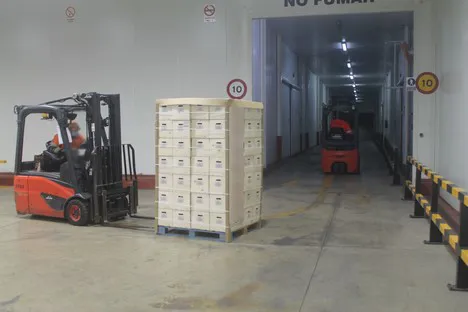
A load of pre-cooled-at-treatment-temperature Spanish oranges is transported to the containers approved for cold treatment.
The US as an example
Spain exports fruits to the US using cold treatment to fight the fruit fly plague since it began to export to that country in the 1979/1980 campaign. In fact, the APHIS-USDA American inspector who will be responsible for the mandatory inspection at origin (preclearance) up until December 20 (for the moment) arrived in Valencia on October 11. This is happing after three years without exporting to the US due to additional duties imposed on EU citrus, among other products, because of the Airbus-Boeing conflict. So the sector has to start again from scratch, paying in advance the estimated amount necessary to cover said instance to the APHIS.
We've been informed that the person responsible for the cold treatment dossier at the European Commission will visit Valencia in November. We hope that he or she will have enough time to attend in person an inspection at the origin of APHIS-USDA (together with the Spanish Phytosanitary Inspection Service), to make sure we rigorously comply with the cold treatment standard imposed on us by the Americans, including the pre-cooling of the fruit's core to treatment temperature and with the recording of core temperature by means of three core sensors inserted in the central part of the fruit, just like the cold treatment protocol against the ‘False Codling Moth’ that South Africa must comply with to export its products to the US.
As we work hard so that the first cold treatment imposed by the EU is implemented right to achieve the necessary and indispensable phytosanitary protection of our citrus plantations against the ‘False Codling Moth’, the treatments against South Africa's Cotonet have unleashed the presence of the red spider in the Valencian Community, with the consequent increase of losses in storage.
It's worth noting that spending on pest control, in the Valencian Community alone, has tripled from 2018 to 2021, going from €6.2 million in 2018 to €18.4 million in 2021. The great increase in spending last year is determined by the fight against Xylella and, above all, against ‘South Africa's Cotonet’ for the promotion of biocontrol techniques (biological control with parasitoids and predators, as well as the use of massive trapping with pheromones). This doesn't include the treatments carried out by the farmers. Delottococcus aberiae is causing significant direct damage estimated at more than 82 million euro per year.
It's worth noting that there would be no difference in cold treatment controls in EU imports of oranges originating in South Africa if South African exporters just complied with what ISPM 42 indicates regarding the temperature records of the product taken with three core sensors, that is, inside the product's pulp, not of the air inside the container, if they also precooled the product at the temperatures and in the periods prior to shipment that set as a general rule by their own Official Export Certification Agency (the PPECB), and if they complied with the export protocol to the EU with the same thoroughness and care as they do in their exports to the United States. There's no doubt about it.
What they describe as different interpretations are simply subterfuges to avoid complying with the protocol established for oranges imported into the EU from countries with ‘False Codling Moth’. We can see through their continuous unfounded complaints, the reference to the annoyances, difficulties, and serious economic damage they've had because of the EU protocol alone (the US protocol apparently does not cause them any problems), and their total lack of co-responsibility in protecting EU citrus production against quarantine pests.
Summary 1: First conclusion: South Africa has admitted to the non-compliance with the cold protocol on the grounds of “differences of interpretation”. The EU regulation explicitly refers to the NIMF-42 standard, which requires the temperature treatment to be applied to the core of the commodity (i.e. in the fruit), not to the container's air temperature (set point temperature, as claimed by the South African CGA).
Summary 2: Second conclusion: A majority of EU importing countries isn't complying with the import control and verification of cold treatment compliance. This is happening because they are accepting South Africa's ‘interpretation’ of the precooling temperature, they are wrongly accepting the temperatures being recorded to validate the treatment, and because the official certificates of origin are being validated without further ado.
Summary 3: What they describe as “differences of interpretation” are simply subterfuges for not complying with the protocol. Their continuous unfounded complaints, the reference to the difficulties and serious economic damage they suffer from the EU protocol contrast with the silence they maintain with the same issues caused by the US protocol, which is more demanding but, apparently, does not cause them any problems.
Summary 4: Meanwhile, public spending on pest control in the Valencian Community alone has tripled due to Xylella and the ‘South Africa's Cotonet', the latter of which causes annual losses estimated at more than 82 million euro and whose treatments have caused an increase in red spider, which also increases loses in storage.
